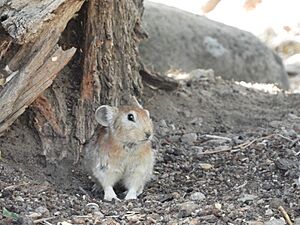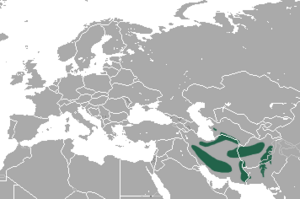Afghan pika facts for kids
Quick facts for kids Afghan pika |
|
|---|---|
 |
|
| Conservation status | |
| Scientific classification | |
| Genus: |
Ochotona
|
| Species: |
rufescens
|
 |
|
| Afghan pika range | |
The Afghan pika (Ochotona rufescens) is a small, furry animal. It belongs to the pika family, which is related to rabbits. You can find these pikas in countries like Afghanistan, Iran, Pakistan, and Turkmenistan. Experts say they are not currently in danger of disappearing.
Contents
How Scientists Name Them
The Afghan pika was first officially described in 1842. A scientist named John Edward Gray gave it its scientific name. He found it near Kabul, which is in Afghanistan.
There are three main types, or subspecies, of the Afghan pika. These are Ochotona r. rufescens, Ochotona r. regina, and Ochotona r. shukurovoi.
What Does It Look Like?
The Afghan pika is a small mammal. It is part of a group called lagomorphs, which also includes rabbits and hares. It has a small head with round ears. Its legs are short and covered in thick fur. Even the bottoms of its feet are furry!
Its fur is a reddish-brown color. It has a cream-colored band of fur around its neck. The fur on its belly is much lighter.
Where Do They Live?
Afghan pikas live in the mountains of Afghanistan, Iran, Pakistan, and southwestern Turkmenistan. They can be found at high places, from about 1,900 to 3,500 meters (6,200 to 11,500 feet) above sea level.
They like rocky desert areas where there are not many plants. They also live in juniper woodlands.
How Do They Live?
Afghan pikas live in burrows, which are tunnels they dig underground. They are most active during the day, especially in the morning.
They eat plants like Ephedra, Artemisia, and thistles. They sometimes cut plant stems and leaves. Then they dry them in the sun before storing them in their burrows for later.
The breeding season for Afghan pikas is from March to September. During this time, a female pika can have up to five litters of babies. Each litter usually has about six young. Babies born early in the season can grow up quickly. They might even have their own babies in the same year!
Is the Afghan Pika Safe?
The Afghan pika lives in many places, and its numbers seem to be stable. This animal usually lives in rocky, dry areas. However, it can also live near farms, in fruit orchards, or even in walls made of mud bricks.
In some places, people see them as a problem. This is because they eat crops and can damage fruit trees. Because of this, people might try to get rid of them.
The International Union for Conservation of Nature (IUCN) says the Afghan pika is of "least concern". This means they are not currently in danger of becoming extinct. However, a small group of pikas living on the Small Balkhan Ridge might be at risk.



